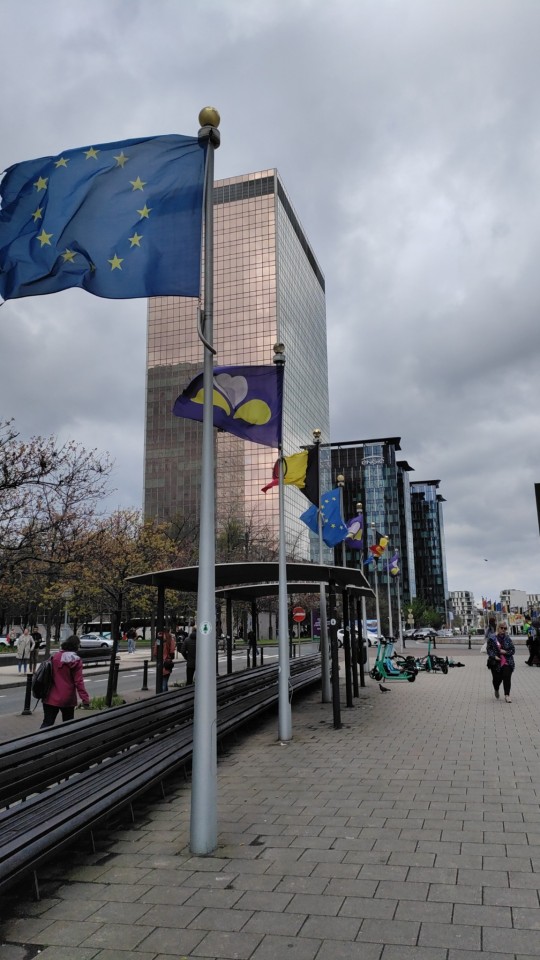#VAT
Text


Two different flavors of Durge
#vat (the drow) is basically just as bad as Orin is he’s just a bit more charismatic djdjdjdjjs#Dragonborn still needs a name- but he does not wish to hurt his new friends djdjjdjdjd he’s very worried about doing that#doodle#sketch#Baldur’s gate 3#bg3#bg3 astarion#bg3 shadowheart#bg3 durge#durge#the dark urge#oc#vat#(g. get it. cause vat is tav backwards sjsjjsjs)#tw blood#ask to tag#Vat’il
185 notes
·
View notes
Text




08-05-2023
It's been a while since I posted :(
I already finished 8 weeks of my 11 week internship at the Belgian federal tax administration. My team works on appeals made by companies about VAT.
In the beginning I worked on old files that were already closed so I could practise. But now I'm working on current files and it feels nice being needed.
I'm so tired though. I've postponed my thesis to august because I feel dead when I get back home in the evening.
I really have to start writing my thesis report though. I've been procrastinating on that as well lol. I need to submit that at the end of may but my mentor needs to read it first because of confidentiality so I should probably finish writing it a week before the deadline.
I have started applying for jobs already! I applied for 2 jobs at tax administration where I'm doing my internship and maybe I get offered a contract when I'm finished. We'll see what happens
#mystudydiary#mystudydiary-blog#studyblr#internship#tax administration#taxation#vat#value added tax#productivity#university#my post#may 2023
80 notes
·
View notes
Text
Me: *using VATS*
Nick Valentine:


Wnnsnsnsn nick is READY.
#fallout 4#nick valentine#someone add the red laser eyes to the picture#sjsjsnns#🤣🤣🤣🤣#lol#screenshot#screenshots#photoset#VAT#VATs
394 notes
·
View notes
Text
For the love of god why is VAT so horrible
Ok so I am TRYING to make sense of VAT so I can allow commissions to the UK, even though every time I start reading about it I want to crawl into the fetal position.
If I understand correctly, for a sale that is worth less than £135, the seller is responsible for remitting VAT. If the sale is worth more than £135, the recipient is responsible for paying VAT. (I guess customs will hold the package until the recipient pays up?)
If this is the case, theoretically I could avoid personally dealing with VAT by having commissions worth less than £135 paid for via Etsy (because they collect and remit VAT), and commissions worth more than £135 can go directly through Paypal and VAT is the client's problem. LOL.
Someone please tell me if this is correct. 😭
One issue, though, is that if I sell a commission via Etsy, I don't want to ship it with an Etsy label. Do Etsy labels have some kind of indication that VAT has been paid? If I make my own label, will the client be charged VAT again? Or does UK Customs assume packages with a value less than £135 have already had the VAT taken care of?
And the most important question of all, why is the UK tormenting everyone with this shit????
12 notes
·
View notes
Text

537 notes
·
View notes
Text

Y’all can not convince me Nuru has no rizz she got gameeee frfrrrr Varian and Hugo wish they were her their awkward loser boy asses could never compare to the godly rizz she holds.
#jk I love varigooo#nuru got bitches simping 4 her the moment she walk out that caravan and say hi#varigo#nuru vat7k#vat7k varian#vat7k au#vat#tts#tangled the series#tts varian#rapunzles tangled adventure#varian#varian vat7k#varian and the 7 kingdoms#hugo vat7k#vat7k hugo#vat7k#varian x hugo#varian and hugo#varian and the seven kingdoms#rta varian#rta
32 notes
·
View notes
Photo

More than 170 countries worldwide—including all European countries—levy a Value-Added Tax (VAT) on goods and services.
by @TaxFoundation
60 notes
·
View notes
Text
International Taxes
Ko-Fi prompt from Ethan:
All I know about tariffs is that they're special taxes for international trade but people talk about them all the time. Please help explain
So we are going to talk about three things here:
Tariffs
VAT
Customs/Duties
I'll be using the US for most of my examples, because that's what I know best... and also because it's a very convenient example for the way VAT works on an international level.
Tariffs
You are correct that tariffs are special taxes for international trade. These are essentially fees that are applied to products being shipped in and out of a country in order to promote domestic product or impact a foreign one.
A common example is US steel. The United States has a fairly robust steel industry, and the government promotes that industry domestically by applying tariffs to imports. Back in 2018, Trump imposed a 25% tariff on steel imports and 10% on aluminum (something that the WTO said was illegal, but that's not relevant right now). The steel tariff had previously been a range of 8-30%, implemented by Bush in 2002. Prior to that, the steel tariff had generally been under 1%.
In applying that tariff, the federal government prioritized domestic purchasing. If domestic product is nominally $90 for one unit, and foreign product is $80, then it is cheaper and more appealing to buy from a foreign producer. With a 25% tariff, the foreign product is now functionally $100 per unit, making it more appealing to buy domestically. While the actual cost of the tax is born by the producing country, in the case of import tariffs, the result is the raising of costs when selling internationally.
Tariffs are also applied to specific countries. Once again using a Trump example, a $50 billion tariff was applied against China in 2018. This had negative impacts on the economy, as it led to worries of a trade war; China did retaliate by applying tariffs directly to specific products from the US, including wine and pork.
High tariffs theoretically lead to an increase in domestic trade, but they also lead to higher rates of smuggling. They are also a form protectionist policy, which was at its height in the 19th century for the US.
VAT - Value Added Tax
If you look up VAT, you get a lot of explanations that talk about how it is a tax that is levied against the consumer on the basis of the cumulative value of the product, and generally things are confusingly worded, so I'll save you some time:
It's sales tax.
If you are American like me, that's all it is. It's a different name for sales tax.
You get something for $8 at the store, but the final cost is $8.42? Those 42 cents are the VAT.
What does that have to do with international trade? Isn't that a domestic thing?
Well, yes and no. We'll start by comparing the US to most European countries.
See, the US has a different application of VAT than a lot of other places. In the US, sales tax is added at the very end of a purchase for the vast majority of places. This is because there is no federal sales tax. Instead, taxes are set by the state, county, and city governments. Take a look at this map of New York, and you'll see how much sales tax varies by just a few miles.
Given how much a pricing can vary from one town to the next, large corporations generate a greater profit by listing prices in their pre-tax form, and then adding that tax at the end. The consumer knows that there will be a higher price at the counter than is listed, because the standard in the US is to not include that tax. So your Arizona Iced Tea will be a $1 in Portland and $1 in Queens County, matching that promise on the can... but you'll still be paying $1 in Portland and $1.09 in Queens, because only one of those areas has sales tax, despite both being in the same country.
This works out for the retailer, because the consumer does not blame them for raising prices across county lines, if there is a sales tax hike. The thought of "it's cheaper ten miles down the road, I'll get to it later," followed by never getting to it and thus never making a purchase, is rarer, because the listed price is still the same. It also means having to print or design fewer price tags; imagine having to manually change every price in a supermarket magazine! Every coupon needs to have its price changed by a few cents, to account for tax!
...or you can just print the same magazine with the same prices and write "plus tax" after the listed cost.
All this to say, Americans are used to adding sales tax at the end, and knowing that the price they see is not the price they'll pay.
Other countries Do Not Do This.
I mean, some do. But we're talking about the ones that don't, which includes the entirety of the EU, India, some of Japan, and the country I actually have extensive experience with: Serbia.
I am currently in Serbia, which means I'm in a country with a sales tax/VAT that is higher than I'm used to (20% on most goods, 8% on essentials). In every store I've been to, the tax is included in the listed price. If it says 87 rsd on a carton of milk, I will be paying 87 rsd at checkout. The baseline price is 80 rsd, and then there's the 8% tax, and the final price is 86.4, which gets rounded up to the 87 that is listed on the tag.
If you aren't accustomed to thinking about VAT like in the US, online shopping can be... a trial.
If I purchase something from, say, Canada, and have it mailed to the US, I am given the sales tax as part of the purchasing process. It will format the receipt as the product plus sales tax. This is familiar to me.
To someone from the EU who does not purchase internationally (specifically from the US, Canada, or other countries that don't include sales tax in the sticker price), this tax can often come as a surprise.
And, finally, in some cases... the will be paid at the very end, at the point of pickup, along with customs. I recently purchased something from an English creator that was manufactured in Germany and then shipped to Serbia. I anticipated that I had paid the VAT for Serbia when purchasing the product. It was instead added at the point of purchase, as Serbia is neither in the EU nor in a trade agreement with the relevant countries that would allow for me to pay the VAT online, I had to pay the 20% in addition to customs when picking up the package from the postal office.
Despite not being a tariff or customs/duty payment, VAT can have a direct impact on international purchasing.
Customs/Duties
Customs and duties are taxes applied to products based on those product characteristics.
There is overlap with tariffs. As a consumer, you are... not going to be very affected by the difference between customs and tariffs.
Customs are like VAT, in that they are paid by the consumer rather than by the manufacturer.
You can think of tariffs as a fee that a manufacturer pays to sell something internationally (though that cost is often passed on to the consumer), and customs as a fee paid by a consumer to receive that good.
Hope this helps!
(And if anyone here is more familiar with the subject than I am, please feel free to add on or correct me! I'm generally pretty good about international policy, but I'm not an expert, and this subject can be a complicated one.)
(Prompt me on ko-fi!)
#taxes#tariffs#taxation#customs#duties#sales tax#vat#phoenix posts#ko fi#ko fi prompts#economics#ko-fi#economics prompts
98 notes
·
View notes
Text


old characters that i'm dredging out of the muck
#thrice#nik#nazarov#sarky#vat#streyker#holy shit. streyker. a character i havent thought of or drawn in literally a decade#cherkesov#maletski
24 notes
·
View notes
Text

Inktober Day 25: Danger
Aco gets dangerous when you forget to pay the weekly discord bean tax
(inspired by the Will Burke's Garfield illustrations)
Aco: catboy (?) streamer at: https://www.twitch.tv/acovt
#inktober#inktober2023#danger#horror#body horror#garfield horror#will burke#catboy#vat#vtuber#kemonomimi
9 notes
·
View notes
Text
pls sign this petition
This petition calls for an end to the 6x1 working schedule where individuals work 6 days a week and only have 1 day off. This mainly affects people who work in shopping malls, pharmacies and service providers. This petition is organized by the VAT movement, for more information please check on the website.

#social justice#socialism#organized labor#unionize#workers rights#unions#labor rights#work life#brazil#working class#VAT
4 notes
·
View notes
Text

06-07-2023
Today I got my grade for my internship. I got 17/20! My mentor was really positive during our feedback convo so I already knew her evaluation was going to be good. I was still a bit scared about my report I wrote about the VAT on renovations though.
This week I'm at uni with other students who are also writing their theses. I feel mich more productive surrounded by other people in the same situation lol, lil bit of peer pressure to not scroll on social media ✨
#studyblr#mystudydiary#mystudydiary-blog#my post#studying#study place#vat#value added tax#taxation#businessadministration#business student#internship#tax administration#master's thesis#july 2023
26 notes
·
View notes
Text

Ticklesworth Tobias
7 notes
·
View notes
Text
TOP 6 - Highest VAT rates in the world - Accounting & Finance blog
TOP 5 – European Union VAT level “leaders”
Top list with member states currently having the highest VAT rates within the EU:
Hungary (27%)
Denmark (25%)
Sweden (25%)
Croatia, Finland, Greece (24%)
Ireland, Poland, Portugal (23%)
There are two main reasons for Hungary’s rise to the top of the VAT charts. The first is the financial crisis which led the Hungarian government to raise the VAT rate to restore the financial balance of the country. The second is that Hungary recently slashed the corporate tax rate to only 9%, partly financed by keeping the highest VAT rate in the European Union. It is under pressure to lower this rate from the EU because there is an indication the high VAT rate is used to finance a very low corporate tax rate to unfairly compete with other EU members about company investments.

Hellóbelló, fideszes zombik, hellóbelló
101 notes
·
View notes
Text
Vat19 Ice Spheres Sparta Remix
Vat19 Ice Spheres Sparta Remix
youtube
#vat19#Ice spheres#Sparta Remix#Vat19 Ice Spheres Sparta Remix#Vat#19#IceSpheres#SpartaRemix#Youtube
3 notes
·
View notes